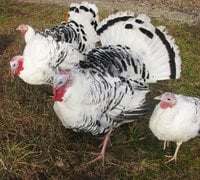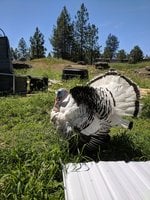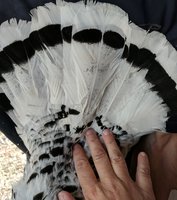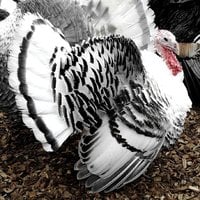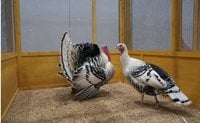TurkeyTimes
Songster
So I want to start a newer thread on this topic. The royal palms in the USA are not meeting the standard written by the APA SOP. I personally think it's a huge issue and not many people are aware of it. Part of the standard written as...
TAIL:Main Tail - pure white with each feather having a broad band of metallic black about 1 1/2 inches in width terminating in pure white at end of tail. COVERTS AND LESSER COVERTS: White with wide
band of metallic black. free of bronze cast, extending across feather near end terminating in a
wide edge of white. It also is suppose to be a DQ if they don't have it.
DISQUALIFICATIONS
Wings showing one or more primary or secondary feathers definitely brown in color. Entire absence of
black edging in neck of toms. Absence of black bands in main tail and greater coverts of both toms and hens.
Not to mention most royal palm lines are muddied with pencilling which should also be a DQ.
So I would like people's thoughts, opinions, comments, concerns, questions on this topic. All pictures of royal palms very helpful! I want to study and survey this! I've attached pictures of typical US royal palms (first 3 pictures) versus some of what they call a Crollwitzer in Europe (last 2 pictures). Same genotype, yet very visible difference in phenotype!! What's going on here?
TAIL:Main Tail - pure white with each feather having a broad band of metallic black about 1 1/2 inches in width terminating in pure white at end of tail. COVERTS AND LESSER COVERTS: White with wide
band of metallic black. free of bronze cast, extending across feather near end terminating in a
wide edge of white. It also is suppose to be a DQ if they don't have it.
DISQUALIFICATIONS
Wings showing one or more primary or secondary feathers definitely brown in color. Entire absence of
black edging in neck of toms. Absence of black bands in main tail and greater coverts of both toms and hens.
Not to mention most royal palm lines are muddied with pencilling which should also be a DQ.
So I would like people's thoughts, opinions, comments, concerns, questions on this topic. All pictures of royal palms very helpful! I want to study and survey this! I've attached pictures of typical US royal palms (first 3 pictures) versus some of what they call a Crollwitzer in Europe (last 2 pictures). Same genotype, yet very visible difference in phenotype!! What's going on here?

